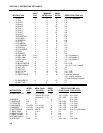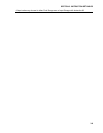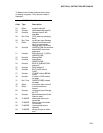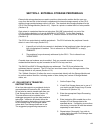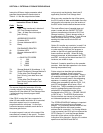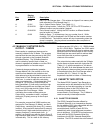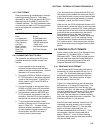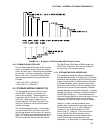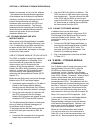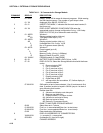
SECTION 4. EXTERNAL STORAGE PERIPHERALS
4-4
the RC35 by switching power through the DC
power line of the SC92A/SC93A.
TABLE 4.3-1 Cassette Recorder
Specifications
Power 6 VDC (provided by
CR10 through SC92A or
SC93A); 4 AA size
batteries; 120 VAC/6
VDC adapter
Current Drain 200 mA typ./5 sec.,
while Recording 300 max.
Tape Length C-60 recommended
Tape Quality Normal bias, high quality
(e.g., TDK, Maxell)
External Inputs Mic., DC In, Monitor, and
Remote
Operating 0° to +40°C
Temperature
POWER SUPPLY
The CR10's internal power supply will power
the recorder during periods of data transfer, but
will NOT be available to play, advance, or back-
up tapes. In order to perform these functions
during setup and check-out operations, the
recorder requires 4 alkaline AA batteries or the
120 VAC adapter.
OPERATING TEMPERATURE LIMITATIONS
The cassette recorder is recommended for use
in an environmental operating temperature
range of 0° to +40°C. Temperatures below 0°C
may cause tape speed variation in excess of
that which can be tolerated during playback. If
the RC35 is outside the 0°C to 40°C range,
data transferred may be unreadable.
VOLUME CONTROL
When recording data, the RC35's volume
setting does not matter. The recorder is
equipped with an automatic gain control which
controls the recorded signal level. For
playback, a mid- range volume setting is
normally required.
CASSETTE TAPES
Normal bias, high quality cassette tapes are
recommended for use with the recorder. The
more expensive high bias chromium oxide
tapes will NOT perform satisfactorily. Although
the use of C-90 tapes is generally successful,
Campbell Scientific recommends the use of C-
60 (30 minutes per side) cassettes. TDK,
Maxell, and equivalent quality cassette tapes
perform well and are readily available. Bargain-
priced tapes have often performed poorly and
are not recommended.
New tapes are often tightly wound, creating
enough drag or pressure to cause the tape
recorder to "pop" out of the record mode. This
potential loss of data may be overcome by fast-
forward/rewinding the entire tape before placing
it in service.
4.3.2 CASSETTE CONNECTOR INTERFACE
CABLES
A cassette interface cable is required to
connect the cassette recorder to the CR10.
Two models are available. The SC92A is a
WRITE ONLY interface. The SC93A is a
READ/WRITE interface that allows the CR10 to
load datalogger programs from tape in addition
to writing data and programs. The SC93A is
required only if special software exists in the
datalogger PROM for transferring programs via
tape (refer to Appendix B)
The SC92A and SC93A have a combination
backshell circuit card and subminiature 9-pin D-
type connector which attaches to the socket
connector on the wiring panel. The other end
of the SC92A has two plugs which are plugged
into the POWER and MIC jacks on the
recorder. The SC93A has three plugs which
are plugged into the POWER, MIC and EAR (or
MONITOR) jacks on the recorder. Both cables
transform 12 V from the CR10 to 6 V for
powering the recorder during periods of data
transfer. Additional circuitry shapes the data
signal waveform.
WARNING: The SC92/SC93 interfaces
previously supplied with the 21X and CR7
dataloggers are not compatible with the
CR10. The SC235 CR21 Cassette
Connector Interface supplied with the CR21
datalogger is not compatible with the CR10.
If the SC92, SC93, or SC235 interfaces are
used with the CR10, the data on tape
CANNOT be recovered!



